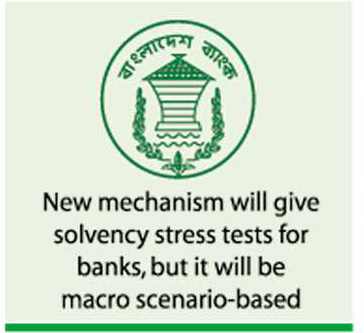The central bank is preparing a stress-testing mechanism that would help the banks better understand their financial strengths in the events of any macroeconomic shock in the country.
It has taken the initiative to formulate the new tools as recommended by the International Monetary Fund (IMF).
Currently, the Financial Stability Department of Bangladesh Bank (BB) conducts regular sensitivity-based stress tests (STs) of all the country's 61 banks to assess the banking sector's resilience in terms of liquidity and solvency position against a broad set of pertinent risks.

To give a firsthand idea about the new methodologies and other best practices, the IMF organised two training programmes - one in India and another in Dhaka in September last - for the officials of the BB and the Ministry of Finance (MoF).
However, according to an official document recently sent to the Financial Institutions Division (FID) of the MoF, seen by the FE, the BB now exercises the test that is literally a "bottom-up" or a type of processing information based on incoming data from the banks concerned or its pertinent environment.
The existing methodology underpinning the current ST infrastructure is a sensitivity analysis implemented in an Excel template, the document reads.
It also reads that defaults of individual and large borrowers, bank rating downgrades, interest rate changes, and equity price fluctuations are the main shocks in the current ST framework.
However, the objective of the new mechanism is to help the BB build macro scenario-based ST infrastructure which can assess the impact of multiple simultaneous macro-financial risks on the banking sector.
The new STs will give solvency stress tests for the banks, but it will be macro scenario-based and able to assess the impact on the bank solvency of a combination of mutually-determined and mutually-consistent shocks.
It will be a "top-down" or comprehensive approach.
People familiar with the matter at the FID told the FE that this new ST framework will be aligned with the international best practices.
"There are many economies that abide by such tests as they fit best with the shocks of the economies," said one official at the FID.
He added that this will strengthen the capacity of the BB departments concerned to monitor systematic risk in the banking sector.
It will also contribute to the BB's risk-based supervision and to better calibrate prudential policy tools, the official said.
This will be able to assess the medium-term impact of a confluence of global and domestic shocks.
The IMF team in their training provided a wide range of methodological and practical aspects of ST, drawing from the current literature and the Basel principle of the stress testing.
IMF also provided "R" training or big data training by its team of econometrics department remotely. The IMF has developed a "workbox" to help build the framework.
The BB will build an IT infrastructure that can automatically process data input and connect various stress-testing modules.
The BB's Financial Stability Department has undertaken a strategy on how to implement it. It will work as the lead in the effort in developing the ST.
It said the finance division may give fiscal projections in designing the ST framework. The division uses IMF-developed tools for fiscal projections.
FID usually works on policy and capital adequacy reviews and for this reason, it can assist in the matter.
The Reserve Management Department of the BB could be an instrument to provide positions and prices relating to holdings of foreign securities and identify vulnerabilities linked to the external sector.
The central bank has departments that deal with data on non-performing loans, write off, and the rate of recoveries.
Currently, the Financial Stability Department releases two publications on the stress tests through the yearly Financial Stability Report and the quarterly Financial Assessment Report.
The BB and other policymakers leverage a number of indicators to provide guidance to the banking sector related to supervision, monitoring, and other operations.
jasimharoon@yahoo.com
rezamumu@gmail.com